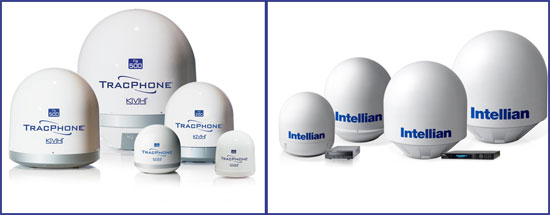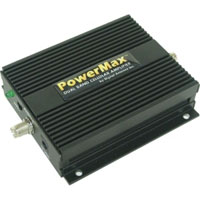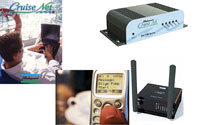Connected While Cruising
Want internet access on the boat? There's probably an option that will fit your preferred cruising and price range.
These days, if you’re not hooked into the ‘net you’re not on planet Earth. We’re wired in our homes, our offices, our cars, and even our coffee shops, so why not on our boats, too? Luckily, in this day and age it’s a piece of cake to stay connected when you’re cruising, with one of three methods: WiFi, cellular, and satellite. As you might guess, your capabilities—and your cost—rise exponentially with each of these systems.

Satellite antennas like these from KVH/Thrane&Thrane and Intellian can provide service just about anywhere.
WiFi
Grab your laptop, step on your boat, and in many marinas BOOM—you’re connected. You may have to pay $10 or $15 to get a passcode and it won’t work when you shove off the dock, but in most major metropolitan areas WiFi is considered a standard marina amenity. Even in public slips and along bulkheads in major cities with a waterfront, the chances are good you’ll be able to draw down the signal from a near-by coffee shop or internet café.
Even outside of metro areas, WiFi is a possibility. On the west coast, one savvy company (Broadband Xpress) provides a roaming broadband service to over 100 marinas in Alaska, British Columbia, and Washington State. Users can tap in from up to three miles from one of the marinas they service, at speeds up to 15 mbps, for a yearly fee of $299. It’s only a matter of time until service providers like this expand from coast to coast.

Antennas can boost your WiFi range, but few are designed for marine use. One exception is the Wirie, which is waterproof to IPX7 standards.
If you’re close to a hotspot but not close enough, you can boost WiFi range with a directional antenna. These are inexpensive at $50 to $100 and can grab a signal from up to a mile away, but most aren’t designed for the marine environment and may have a limited lifespan in a saltwater application. One exception is the Wirie ($250) which is a unit with an IPX7-rated waterproof housing that protects the antenna connections and WiFi adaptor, and is intended for marine use.
Want to save a buck, and you don’t care how silly your boat looks? It’s fairly simple to build your own directional antenna, and it can be done for under $10. (Learn how to make one in a matter of minutes—with a Pringles can.)
CELL
Kick up your connectivity by going cellular and you’ll be able to get better coverage, substantially farther from land. Your computer will need an air card, of course, and your range will be limited to normal cell range. Not good enough? Then think about adding a booster or a repeater, which will increase your capabilities even more.
Boosters connect directly to your air card and can extend service by up to 50 miles. Digital Antenna’s DA4000, for example, is a $300, three-watt direct-connection cellular amplifier. It will work with most cell phones or air cards and advertises a maximum range extension of 50 miles, but the manufacturer cautions that exact range will depend on antenna height, cabling, and other factors.
Rather than connecting directly to your cell card or phone, repeaters are hard-mounted in your boat and broadcast a local signal. Multiple cell connections can be established at the same time, no cords necessary, but there’s a downside: range extension is cut significantly. Digital Antenna’s 4KMR-30M ($600) can keep you in touch out to about 20 miles, and their 4KSBR-50M ($800) can reach out to about 30 miles.

Digital Antenna boosters and repeaters enhance cell range significantly.
Another cellular option is a dedicated high-speed wireless data system, like Shakespeare’s CruiseNet These systems vary in price (MSRP starts at $1,750 but you can find it from $1,100 to about $1,500). They can also interface with onboard monitors, and act as a security and monitoring system by texting your phone when abnormalities arise aboard. Range is excellent, at up to 50 miles offshore.
If you need e-mail access only - but you need it to be world-wide - you can use your SSB radio to tap into the system. Sailmail is a slow but reliable radio data transfer system that allows you up to 90 minutes of airtime per week, for a $250 yearly membership fee. You'll need a Pactor modem and cabling to connect your radio and your laptop (which can run between $1,000 and $1,500) and the data transfer rate is extremely slow (110 to 4800 baud), but there aren't any per-character data fees; check it out at the Sailmail website.
Satellite
Boaters who want to stay in touch whether they’re cruising inside Cape Hatteras or outside Cape Horn will want to go the satellite route. Inmarsat’s satellite constellation can keep you connected virtually anywhere—but you’ll have to pay big bucks to make it happen.
Naturally you’ll need a satellite antenna, and size matters; the larger (and more expensive) an antenna you have, the larger a data stream it can provide. Intellian, JRC, KVH, and Thrane & Thrane all offer antennas that utilize the Inmarsat system, and pricing ranges from about $3,000 to well over $30,000. And that, of course, is just for the hardware. Installation costs commonly run into the thousands, monthly fees can range from $100 to $1,000, and per-use data fees can run anywhere from $6 to $14 per MB. Worldwide cruisers with a bad surfing habit could easily rack up monthly bills that run into the thousands.

Shakespeare’s Cruisenet is a dedicated high-speed wireless data system based on cell service.
There are some basic systems that keep cost relatively low, like KVH’s ETRAC ($3,250), which supports e-mail and position reporting/poling on the mini-C system, only. E-mail pricing runs one cent per character, and the extremely compact antenna (2.4 pound, 6”) means even the smallest boats can support it.
Mid-range units, like Intellian’s Fleetbroadband FB150, cost closer to $7,500 and have relatively compact domes, at about 12 inches and eight pounds. But the systems capabilities are vastly expanded, and the FB150 can provide both voice and data service, LAN interface and router features, and IP connections. The most limiting factor of the middle-of-the-pack choice? The data rate is 150 kbps.
At the opposite end of the spectrum, Thrane & Thrane’s Fleetbroadband 500 system has a screaming 432 kbps data rate. Its three-axis stabilized antenna lives inside of a 26-inch, 42 pound dome unit, and hardware costs alone reach around $23,000. But this giant dome provides giant service, with that fast data rate providing all the phone and Internet coverage you could possibly need.
Whichever one of these options best fits your needs, one thing is clear: in the year 2010 and beyond, being out to sea does not necessarily mean you’re out of touch. So choose your method, and get connected—using the net on a boat no longer necessarily means you’ll be scooping up fish.
 Lenny Rudow has been a writer and editor in the marine field for over two decades and has authored five books. He runs his own web site at HookedOnFishingBoats.com and his syndicated blog appears at Boats.com in the BoaterMouth blog section.
Lenny Rudow has been a writer and editor in the marine field for over two decades and has authored five books. He runs his own web site at HookedOnFishingBoats.com and his syndicated blog appears at Boats.com in the BoaterMouth blog section.












